#python modules import error
Explore tagged Tumblr posts
Text
how to download (and mirror and transcribe) youtube videos
so the news that google is deleting inactive youtube channels was a miscommunication -- "Additionally, we do not have plans to delete accounts with YouTube videos at this time" (source, emphasis mine). but i hope this was a wake up call that archiving videos (and other content) you care about is really important. buy hard drives, save, reshare. videos dont stay up forever. youtube isnt forever.
i know how difficult it is to get into downloading videos, with how all youtube to mp4 websites seem to be broken. this post compiles general guides on how to manually download youtube videos (among other actions) through python programs. it's simple if you just follow the steps and constantly search the errors you encounter. i will also detail how i personally do it with my windows 10 pc, in case you use the same tools.
remember: your search engine, reddit, github, and help commands are your best friends.
* downloading youtube videos
reddit yt-dlp guide
original yt-dlp guide
how to download the best quality mp4
how to download videos from a search result
how to use command prompt
what is command prompt? this is a windows application where you navigate folders and run programs. you just type a command and hit enter. ctrl+c ends a command/program, ctrl+s pauses it (pressing any key unpauses)
how do i navigate folders? the basic commands are so: a) cd "[path]" to change directory (always put path and link names in double quotes so they are processed properly), b) cd .\.. takes you to the previous folder (ex: if you're in C:\folder A\folder B and run cd .\.. you go to C:\folder A), c) you can go to other drives by typing the letter and colon (ex: if you are in C:, typing D: then entering takes you to your D drive). this is important because where your python programs are stored is where you have to run them.
how to run python programs through cmd prompt? a) download the latest version of python. b) use pip to install programs. c) make sure you have also downloaded a program's dependencies (analogous to "pre-requisites"). d) type the program name then the command.
make sure to always update python and pip.
how to use yt-dlp to download youtube videos
how to get download yt-dlp? this guide worked perfectly for me. make sure to download all python programs in the same folder.
navigate to the folder you installed yt-dlp
the following are examples of commands you can use:
yt-dlp -h -- get a list of all commands
yt-dlp "[link]" -- download video as is (often in webm format)
yt-dlp "[link]" -f "bestvideo[ext=mp4]+bestaudio[ext=m4a]/best[ext=mp4]/best" -- download the highest quality mp4 video (highest possible in mp4 is 1080p)
yt-dlp -x --audio-format mp3 "[link]" -- download audio only as mp3
yt-dlp -i "[playlist link]" -- download a full playlist (you may also use the best quality command here)
yt-dlp -i "[playlist link]" --playlist-items [range] -- download range of playlist items
look at the guides at the top of this section for my ideas of what you can do with yt-dlp. you can even use yt-dlp to download from other websites
note: if you want to download instagram reels, you must include: --cookies-from-browser [firefox / chrome / etc] -- choose your browser
** mirroring youtube videos to archive.org
github tubeup guide: "tubeup uses yt-dlp to download a Youtube video (or any other provider supported by yt-dlp), and then uploads it with all metadata to the Internet Archive using the python module internetarchive."
this guide shows you how to install and use the program. this is an easy way to archive videos with the proper metadata -- do not archive videos en masse
the mirrortube archive.org community
*** transcribing videos
transcribing youtube videos w/o downloading: application
transcribing any downloaded video: openai guide
extra1: searching videos
ive seen confusion on how to naviagte youtube search these days. i know!!!! here are some tips:
changing search options to search by upload date shows *ACTUAL* results, rather than suggestions.
the same google tricks work on youtube: google tricks guide
using yt-dlp to search can be helpful to search youtube more precisely
extra2: downloading twitter videos online
i use this regularly, so i thought id also share.

75 notes
·
View notes
Text
Python Day 2
Today I am starting off with exercise 13. Exercise 13 introduces the concepts of variables, modules, and argv.
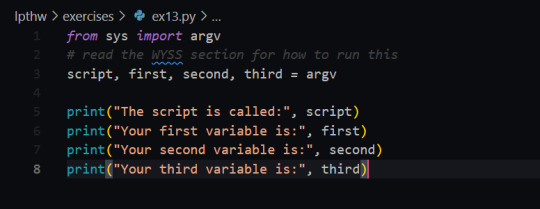
[ID: Exercise 13 code. It imports the argv module from sys, then uses argv to create 4 variables, script, first, second, and third. Next print() is used to print out the different variables /ID]





When calling the program I was confused as to why I got the error of too many variables. Looking into this I found that the first variable of 'argv' is always going to be the script. I then fixed that and added in script as the first variable.
Next for the study drill I wrote a new variable and updated the code to print the retrieved information.


Alrighty then - onto exercise 14. Exercise 14 is about practicing prompts and variables.
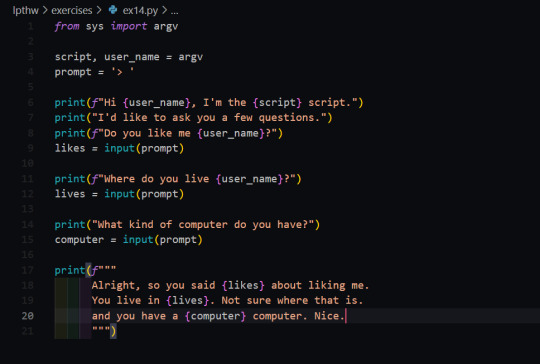
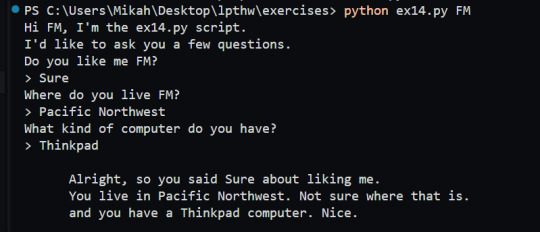
In the study drills I updated the script with a new prompt and print statement.
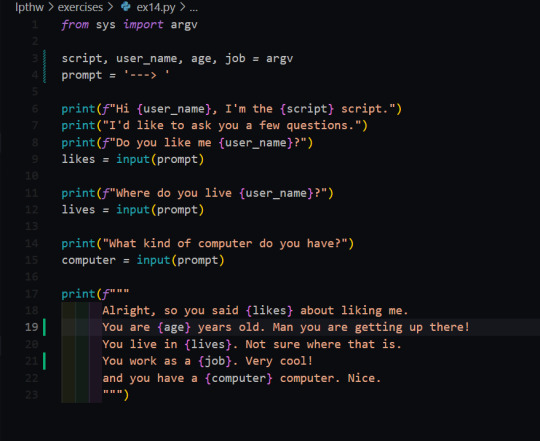
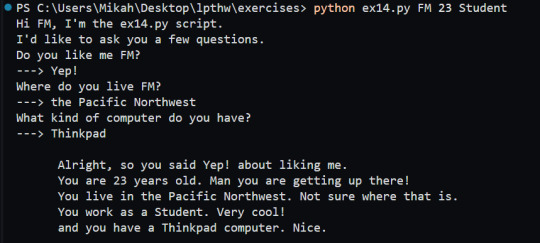
Exercise 15 is a simple program that prints out the contents of a file. An important thing to note is to always close the file when doing things like this!
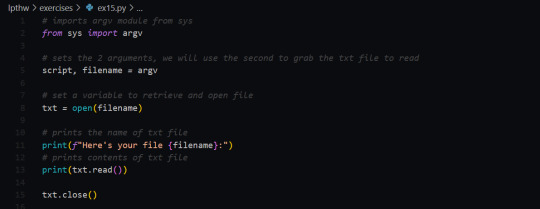
Exercise 16 practices making a copy of a file and then updating it with 3 lines from user input.
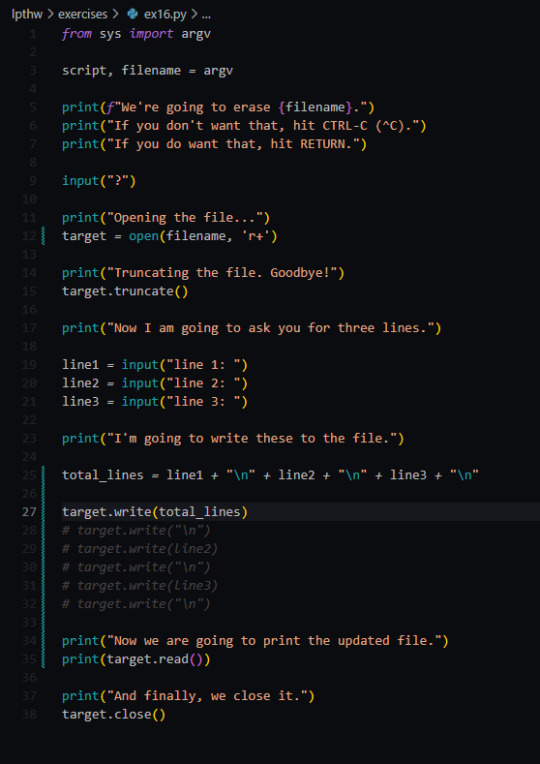
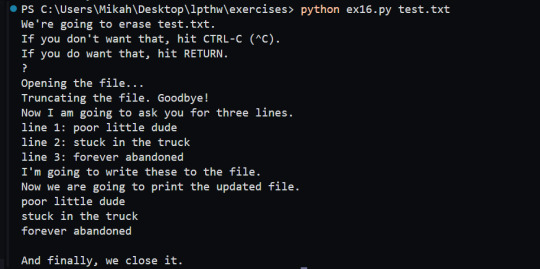
I ended up running into the issue where it was saying that it couldn't read the file. I ended up finding out that .read() starts from the cursor position - and if the cursor is at the end of the file from writing it you will not have your file printed.


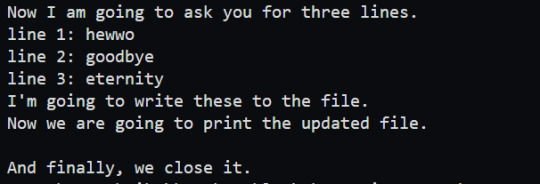
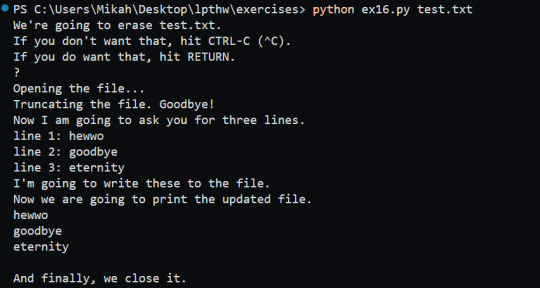
Exercise 17 is practicing copying files over and was relatively simple.
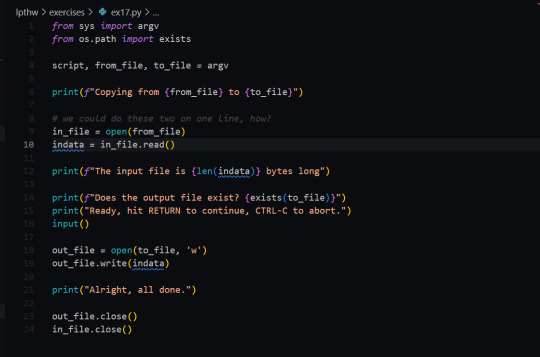

#learn python with F.M.#learn to code#learn python#coding resources#python#coding#lpthw#transgender programmer#codeblr#code#image undescribed#Sorry for not adding ID folks - my spoons are too low
4 notes
·
View notes
Text
qLDPC Library:Quantum Error-Correcting Code Research

Library qLDPC
Infleqtion researchers and JPMorgan Chase introduced a new open-source research software library today to speed up quantum application efficiency efforts. The Economist Commercialising Quantum conference in London on May 13–14 will provide more details on the news.
In conjunction with JPMorgan Chase, Infleqtion researchers created the open-source qLDPC library. Available on GitHub.
The main reason for this package was to help build and analyse quantum low density parity check (qLDPC) codes. However, the library tools also work for general error-correcting stabiliser and subsystem codes.
Reducing the number of physical qubits needed for quantum error correcting is one of the qLDPC library's biggest benefits. This library reduces fault-tolerant quantum computing hardware requirements by 10–100x. A single logical, error-corrected qubit used to need 1,500 physical qubits to work reliably. This new library may lower the requirement to 15–150 physical qubits per logical qubit, depending on implementation. This breakthrough fixes a scaling quantum system bottleneck.
The qLDPC library tools suit Infleqtion's neutral atom-based quantum computing technology. Infleqtion's hardware enables for extremely customisable qubit layouts, enabling the library's more efficient error-correcting codes.
The open-source library qLDPC is meant for collaboration. Developers, academics, and hardware partners can directly interact with the codebase to find new error correction and quantum workload optimisation approaches across platforms.
Important qLDPC library features include:
ClassicalCode: A class for classical linear error-correcting codes over finite fields, featuring pre-defined families and GAP/GUAVA package communication for more codes.
A class for creating stabiliser and subsystem Galois-qudit codes. Get_logical_ops, concatenate, and get_distance perform nontrivial logical Pauli operator construction, code concatenation, and code distance computation, respectively.
CSSCode: QuditCode subclass for building quantum CSS codes from two suitable ClassicalCodes. It uses research paper approaches to estimate code distance upper bounds in get_distance_bound.
Special quantum code constructs and family classes:
Two-block quantum codes.
BBCode, bivariate bicycle codes, including toric layout identification (like long-distance checks) and neutral atom qubit layouts that minimise communication distance. Several arXiv papers mention these constructs.
Product hypergraph codes.
Product codes for subsystem hypergraphs.
Subsystem hypergraph product codes simplex.
Lifted product codes.
Quantum Tanner codes.
decoders.py: BP-OSD, BP-LSD, belief-field, minimum-weight perfect matching, and additional error decoding modules.An interface for custom decoders is included.
Abstract algebra (groups, algebras, representations) module in Python. It communicates with GAP and GroupNames.org and uses SymPy pre-defined groups.
objects.py: A package for building quantum code auxiliary objects like Cayley and chain complexes.
qldpc.circuits.get_transversal_ops: A qubit code subroutine that constructs all SWAP-transversal logical Clifford gates in one code block, but it has exponential complexity and is more suitable for small-to-moderate codes.
Package requires Python >= 3.10 and can be installed via PyPI or source. C compilers for Windows and cvxpy for macOS may be required.
The project wants detailed documentation, however the current material is outdated. For help using the library's classes and methods, consult the source code, comments, examples directory, and test files.
#qLDPClibrary#quantumlowdensityparitycheck#qLDPC#quantumcode#QTCode#technology#technews#news#technologynews#technologytrends#govindhtech
0 notes
Text
Python Training in Chandigarh: Unlocking a Future in Programming
In today’s fast-paced digital world, programming has become a core skill across numerous industries. Among all programming languages, Python stands out due to its simplicity, versatility, and powerful capabilities. As a result, Python training has become one of the most sought-after courses for students, professionals, and aspiring developers. In Chandigarh, a city known for its educational institutions and growing IT ecosystem, Python training opens up exciting career opportunities for learners of all levels.
Why Learn Python?
Python is an interpreted, high-level, general-purpose programming language that emphasizes code readability with its clear syntax. It supports multiple programming paradigms, including procedural, object-oriented, and functional programming. Python has grown rapidly in popularity, currently ranking as one of the top programming languages worldwide.
Some of the key reasons to learn Python include:
Ease of learning: Python has a gentle learning curve, making it ideal for beginners.
Versatility: It’s used in web development, data science, artificial intelligence, automation, game development, and more.
Strong community support: Python has a vast library ecosystem and an active community that contributes to open-source tools and frameworks.
High demand: From startups to tech giants like Google, Facebook, and Netflix, Python developers are in high demand globally.
The Growing Demand for Python in India
India's digital transformation has resulted in a booming demand for skilled programmers. Python, being at the center of technologies like machine learning, data analytics, and artificial intelligence, is a critical skill in the current job market. According to recent job market surveys, Python is consistently among the top 3 most requested skills in software development roles.
Industries such as finance, healthcare, education, and e-commerce in India are actively seeking professionals with Python expertise. As the use of big data and automation expands, the demand for Python-trained professionals is expected to rise even more.
Why Choose Chandigarh for Python Training?
Chandigarh, the capital of Punjab and Haryana, is emerging as a technology hub in North India. Known for its well-planned infrastructure and high quality of life, the city is home to several IT companies, startups, and training institutes.
Key reasons to choose Chandigarh for Python training:
High-quality education centers: Chandigarh hosts some of the best training institutes offering Python courses with practical, project-based learning.
Affordable living: Compared to metropolitan cities, Chandigarh offers cost-effective training and living expenses.
Growing IT ecosystem: With IT parks and emerging startups, the city offers internship and job opportunities for learners.
Peaceful environment: The city’s clean and organized environment enhances the learning experience.
What to Expect from a Python Training Program in Chandigarh?
Python training programs in Chandigarh cater to both beginners and advanced learners. Whether you are a student, fresher, or working professional looking to upskill, you can find a suitable course.
Course Structure
Most Python training programs include:
Introduction to Python: Basics of syntax, variables, data types, and control structures.
Functions and Modules: Writing reusable code using functions and importing modules.
Object-Oriented Programming: Concepts such as classes, objects, inheritance, and polymorphism.
File Handling: Reading from and writing to files.
Error Handling: Managing exceptions and debugging.
Libraries and Frameworks: Use of popular libraries like NumPy, Pandas, Matplotlib, and frameworks like Flask or Django.
Database Integration: Connecting Python applications with databases like MySQL or SQLite.
Project Work: Real-world projects that test your understanding and give hands-on experience.
Modes of Training
Institutes offer various modes of learning:
Classroom training: Traditional in-person classes with face-to-face interaction.
Online training: Live or recorded sessions accessible from home.
Weekend batches: Ideal for working professionals.
Fast-track courses: For learners who want to complete the course in a shorter time.
Certifications and Placement Support
Most reputed institutes provide certification upon course completion, which can be a great addition to your resume. Some also offer:
Resume-building assistance
Mock interviews
Placement support or job referrals
Internship opportunities with IT firms in Chandigarh
Career Opportunities After Python Training
After completing Python training, learners can pursue various career paths, such as:
Python Developer: Focused on building software applications using Python.
Web Developer: Using frameworks like Django or Flask to build web applications.
Data Analyst: Analyzing data using Pandas, NumPy, and data visualization tools.
Machine Learning Engineer: Building intelligent systems using libraries like Scikit-learn and TensorFlow.
Automation Engineer: Writing scripts for process automation in business and IT environments.
Backend Developer: Creating server-side logic for mobile and web applications.
Top Institutes for Python Training in Chandigarh
While there are many training providers, here are a few well-regarded Python training institutes in Chandigarh (as of recent trends):
CBitss Technologies
ThinkNEXT Technologies
Webtech Learning
Infowiz Software Solutions
Netmax Technologies
Each of these institutes offers various Python courses, including beginner and advanced levels, along with certification and placement support.
Tips for Choosing the Right Python Course
Check the syllabus: Ensure it covers both basics and advanced topics relevant to your goals.
Trainer experience: Look for instructors with industry experience.
Hands-on projects: Courses should include real-world projects for practical exposure.
Student reviews: Read testimonials and online reviews to gauge course quality.
Demo classes: Attend a trial session if available before enrolling.
Conclusion
Python training in Chandigarh offers a gateway to exciting and diverse career opportunities in the tech industry. Whether you aim to become a developer, data analyst, or machine learning expert, Python is a foundational skill that can set you apart in the competitive job market. With its growing tech scene, quality institutes, and supportive learning environment, Chandigarh is an ideal location to begin or advance your Python programming journey.
Investing in Python training today can pave the way for a dynamic career tomorrow.
0 notes
Text
CRM Coding: Building Smarter Customer Relationship Solutions
In today’s business landscape, customer relationships are more than just interactions—they're strategic assets. As companies strive to create meaningful and lasting connections with their audiences, they often turn to CRM systems to manage communication, data, and workflows. But for a CRM (Customer Relationship Management) system to truly reflect a company’s unique operations, it needs more than just setup—it needs smart, effective CRM coding.
CRM coding is the technical backbone behind customized CRM solutions. It involves writing code to tailor the functionality of a CRM platform, create new features, integrate third-party applications, and automate business processes. In essence, CRM coding transforms off-the-shelf CRM tools into powerful, personalized engines for business growth.
What Is CRM Coding?
CRM coding is the process of writing scripts, modules, and integrations that enhance the capabilities of a CRM system. Whether a business is using Salesforce, Zoho, HubSpot, or building a custom CRM from scratch, coding enables developers to make the system perform exactly as needed.
Some of the most common areas of CRM coding include:
Custom Fields and Workflows: Automating data entry, lead tracking, or task assignments.
API Integrations: Connecting the CRM with tools like email platforms, analytics, or payment gateways.
Custom Dashboards: Displaying real-time data in a user-friendly way.
Data Validation Scripts: Ensuring that entries are accurate and consistent.
Security and Role Management: Controlling access based on user roles and permissions.
CRM coding ensures that the software doesn’t just work—it works for you.
Why CRM Coding Is Important for Businesses
Many CRM systems come with great built-in features, but they aren’t always tailored to specific industries or business models. Without proper customization, businesses may face limitations that prevent them from fully leveraging their CRM investment.
Here’s why CRM coding makes a difference:
Improves Efficiency: By automating tasks and workflows, teams save time and reduce manual errors.
Boosts Team Collaboration: Integrated systems allow for smoother information sharing across departments.
Enhances Customer Service: Quick access to detailed customer data means better, more personalized support.
Supports Growth: As businesses evolve, CRM coding allows the system to grow with them.
Increases ROI: A customized CRM aligns better with business goals, improving its overall value.
The Role of Developers in CRM Coding
Behind every well-functioning CRM system is a skilled developer—or a team of them. These professionals understand not only the coding languages involved but also the business logic behind the software.
CRM developers typically work with:
JavaScript for front-end customizations and browser-side scripting
PHP, Python, or Java for back-end logic
SQL for database management and queries
APIs and Webhooks for real-time data synchronization between systems
A successful CRM coding project requires both technical expertise and a clear understanding of the client’s workflows, goals, and customer journey.
Partnering with the Right Development Team
If you’re planning to build or customize a CRM system, finding a reliable development partner is essential. One example of a trusted source for custom CRM development is codingcafe.website. Their team offers tailored CRM solutions, working closely with clients to ensure that every line of code adds value to the business.
From designing custom modules to integrating third-party tools, Coding Cafe focuses on creating CRM systems that are efficient, intuitive, and scalable. Whether you’re building a CRM from scratch or enhancing an existing platform, their approach prioritizes performance, usability, and long-term flexibility.
Looking Ahead: The Future of CRM Coding
As technology evolves, CRM coding is becoming more dynamic. Artificial intelligence, machine learning, and predictive analytics are now being woven into CRM platforms, offering deeper insights and automation. For businesses to stay competitive, adapting their CRM systems to embrace these innovations is becoming increasingly important.
Custom coding ensures that your CRM isn't just reactive—it becomes proactive, offering suggestions, automating decisions, and delivering a smarter experience for both teams and customers.
Final Thoughts
CRM coding is more than a technical process—it's a way to align technology with human connection. A well-coded CRM system supports the unique needs of your business, empowers your team, and builds stronger relationships with your customers.
If you’re ready to take your CRM to the next level, working with experienced developers like those at codingcafe.website can help you create a system that works smarter, not harder.
0 notes
Text
Mastering Python: Tips and Best Practices for Efficient Coding
If you want to enhance your Python skills and become an expert developer, enrolling in the best Python training institute in Hyderabad is the perfect way to start. Python's simplicity and versatility make it a favorite among developers, but writing efficient and optimized code requires best practices and strategic techniques. Here are some tips to help you master Python coding.
1. Write Readable and Clean Code
Use meaningful variable names, follow the PEP 8 style guide, and break long functions into smaller, reusable ones.
def calculate_area(length, width):
return length * width
2. Use List Comprehensions
Code that uses list comprehensions is more concise and readable.
squares = [x**2 for x in range(10)]
3. Optimize Loops and Conditions
Use built-in functions like map(), filter(), and zip() instead of traditional loops for better performance.
numbers = [1, 2, 3, 4, 5]
squared = list(map(lambda x: x**2, numbers))
4. Utilize Generators for Large Data
Generators save memory by yielding values one at a time instead of storing them all at once.
def number_generator():
for i in range(1000):
yield i
5. Leverage Python’s Standard Library
Modules like collections, itertools, and functools provide powerful built-in functions that enhance efficiency.
from collections import Counter
count = Counter("mississippi")
6. Handle Exceptions Properly
Use try-except blocks to manage errors gracefully.
try:
result = 10 / 0
except ZeroDivisionError:
print("Cannot divide by zero!")
7. Use F-Strings for String Formatting
F-strings are more readable and efficient compared to older formatting methods.
name = "Alice"
print(f"Hello, {name}!")
Conclusion
By following these tips, you can write cleaner, faster, and more efficient Python code. To deepen your Python expertise, consider enrolling at Monopoly IT Solutions , the leading training institute in Hyderabad, and gain hands-on industry experience.
0 notes
Text
What is Python Subprocess Ping? When working with Python, sometimes you need to interact with the underlying system to perform operations like executing shell commands. One such common task is sending a ping to another device or server to test its availability. Python provides several ways to do this, and one of the most powerful tools is the subprocess module. The subprocess module allows you to spawn new processes, connect to their input/output/error pipes, and obtain their return codes. In this article, we’ll explore how you can use Python's subprocess module to perform ping operations. Why Use Subprocess? Python has built-in modules like os that allow executing system commands, but subprocess is a more flexible and powerful alternative. The subprocess module not only gives you better control over command execution but also allows for interaction with standard input/output, redirection, and error handling. This makes it ideal for tasks like sending ping commands to check the availability of a server or network device. How to Use Subprocess for Ping The ping command is available on most operating systems, and Python's subprocess module allows you to execute it just like you would in a terminal. Here’s a basic outline of how you can ping a server using the subprocess module. Step-by-Step Code Here’s a simple example of how to use Python's subprocess.run() function to ping a server: import subprocess def ping(host): # Define the command and arguments command = ['ping', '-c', '4', host] # Execute the command and capture the output result = subprocess.run(command, stdout=subprocess.PIPE, stderr=subprocess.PIPE, text=True) if result.returncode == 0: print(f"Ping successful:\nresult.stdout") else: print(f"Ping failed:\nresult.stderr") # Test the function ping('google.com') Explanation of the Code: Importing the Subprocess Module: We start by importing the subprocess module, which contains the functions we need to execute system commands. Defining the Command: The command variable contains the actual ping command we want to run. In this case, we're using ping -c 4, which sends 4 ICMP echo requests (the default is unlimited). Executing the Command: The subprocess.run() function is used to run the command. We pass stdout=subprocess.PIPE and stderr=subprocess.PIPE to capture both the output and any errors generated by the ping command. Handling the Result: The subprocess.run() function returns a result object, which includes the stdout, stderr, and the returncode. A return code of 0 indicates success, while a non-zero return code indicates failure. Handling Different Operating Systems The code above works well for Unix-based systems like Linux and macOS. However, if you're on Windows, the ping command is slightly different, as it doesn’t use the -c option for count but instead uses -n. To make the code cross-platform, you can add an OS check: import subprocess import platform def ping(host): # Check the operating system param = '-n' if platform.system().lower() == 'windows' else '-c' # Define the command and arguments command = ['ping', param, '4', host] # Execute the command and capture the output result = subprocess.run(command, stdout=subprocess.PIPE, stderr=subprocess.PIPE, text=True) if result.returncode == 0: print(f"Ping successful:\nresult.stdout") else: print(f"Ping failed:\nresult.stderr") # Test the function ping('google.com') Now the code works on both Windows and Unix-like systems by adjusting the ping command according to the operating system. Working with Timeouts One of the advantages of using the subprocess.run() function is that it allows you to specify a timeout for command execution. If the ping command takes too long to complete, you might want to stop it and move on. Here’s how you can set a timeout: import subprocess def ping_with_timeout(host, timeout=5):
try: command = ['ping', '-c', '4', host] result = subprocess.run(command, stdout=subprocess.PIPE, stderr=subprocess.PIPE, text=True, timeout=timeout) if result.returncode == 0: print(f"Ping successful:\nresult.stdout") else: print(f"Ping failed:\nresult.stderr") except subprocess.TimeoutExpired: print(f"Ping operation timed out after timeout seconds.") # Test the function ping_with_timeout('google.com', timeout=3) In this example, if the ping command takes longer than 3 seconds to complete, the function will raise a TimeoutExpired exception and notify the user that the operation timed out. Advantages of Subprocess for Ping Using subprocess for pinging has several advantages: Flexibility: You can customize the ping command with different options, like changing the count of ICMP requests or adjusting the timeout. Error Handling: Subprocess provides detailed error handling. You can capture and display errors using stderr, and easily check if a ping operation failed by looking at the returncode. Cross-Platform: With some tweaks, you can write code that works across different operating systems. Conclusion Python’s subprocess module is an excellent tool for executing system commands like ping. It offers flexibility, robust error handling, and cross-platform compatibility, making it a great choice for scripting and network-related tasks. Whether you're building network tools or just automating system checks, understanding how to use subprocess for pinging can greatly enhance the functionality of your Python scripts.
0 notes
Text
Price: [price_with_discount] (as of [price_update_date] - Details) [ad_1] This book provides a comprehensive and thorough introduction to Python, a popular programming language used by various top companies across various domains. Whether you are a novice starting your programming journey or an experienced programmer looking to expand your skill set, this book is designed to assist you in mastering core Python concepts. Starting with the basics, this book guides you through the setup, basic commands, and key language rules. The book covers important ideas like different types of data, variables, and how to control the flow of your programs. You will also learn about collections for organizing data, functions for reusable code, modules for organizing bigger projects, and object-oriented programming for modeling real-world things. Advanced topics include customizing object behavior, efficient data processing, modifying function behavior, and handling errors gracefully. Publisher : Bpb Publications (18 June 2024); BPB Publications, 20 Ansari Road, Darya Ganj, New Delhi-110002, India Language : English Paperback : 710 pages ISBN-10 : 935551655X ISBN-13 : 978-9355516558 Reading age : 12 years and up Item Weight : 1 kg 230 g Dimensions : 19.3 x 4.06 x 24.13 cm Country of Origin : India Packer : BPB Publications, 20 Ansari Road, Darya Ganj, New Delhi-110002, India [ad_2]
0 notes
Text
The Role of Automation in DevOps: Beyond CI/CD

Infrastructure as Code (IaC) & Configuration Management in DevOps Automation
In modern DevOps practices, Infrastructure as Code (IaC) and Configuration Management play a vital role in automating infrastructure provisioning, scaling, and maintenance. These practices help teams manage complex environments efficiently while ensuring consistency, scalability, and security.
1. Infrastructure as Code (IaC): Automating Infrastructure Provisioning
What is IaC?
Infrastructure as Code (IaC) is a practice that allows developers to define and manage infrastructure through code, rather than manual processes. This ensures consistency, repeatability, and scalability across environments.
Benefits of IaC:
✅ Eliminates Manual Configuration Errors — Reduces human intervention and mistakes. ✅ Speeds Up Deployments — Automates provisioning of servers, databases, and networking. ✅ Enhances Scalability — Dynamically provisions and scales infrastructure as needed. ✅ Improves Disaster Recovery — Infrastructure can be rebuilt quickly using stored configurations.
Popular IaC Tools:
Terraform — Cloud-agnostic tool for defining infrastructure using declarative syntax.
AWS CloudFormation — AWS-specific IaC tool for automating cloud resource creation.
Pulumi — Uses familiar programming languages (Python, TypeScript, Go) for infrastructure automation.
Azure Resource Manager (ARM) — Automates infrastructure deployment on Azure.
Example: Terraform Script for Provisioning an EC2 Instance in AWS
hprovider "aws" { region = "us-east-1" }resource "aws_instance" "example" { ami = "ami-0c55b159cbfafe1f0" # Replace with a valid AMI ID instance_type = "t2.micro" tags = { Name = "MyTerraformInstance" } }
This Terraform script provisions an EC2 instance in AWS, ensuring consistency across multiple deployments.
2. Configuration Management: Automating System Configurations
What is Configuration Management?
Configuration Management (CM) automates the setup and maintenance of software, ensuring all systems are configured consistently and correctly across different environments.
Why is Configuration Management Important?
✅ Ensures Consistency — Standardizes configurations across all servers. ✅ Simplifies Updates & Patching — Automates software updates and system changes. ✅ Enhances Security — Ensures systems comply with security policies. ✅ Enables Faster Disaster Recovery — Quickly restores failed configurations.
Popular Configuration Management Tools:
Ansible — Agentless automation tool using YAML playbooks.
Chef — Uses Ruby-based recipes for system automation.
Puppet — Declarative automation for large-scale environments.
SaltStack — High-speed, event-driven automation.
Example: Ansible Playbook to Install Apache on a Server
yaml- name: Install Apache Web Server hosts: web_servers become: yes tasks: - name: Install Apache apt: name: apache2 state: present - name: Start Apache Service service: name: apache2 state: started
This Ansible playbook installs and starts Apache on a group of web servers automatically.
3. Best Practices for Implementing IaC & Configuration Management
✅ Use Version Control (Git, GitHub, GitLab) — Store infrastructure code in repositories for tracking changes. ✅ Follow the DRY Principle (Don’t Repeat Yourself) — Reuse modules and scripts to reduce duplication. ✅ Implement Security Best Practices — Avoid hardcoded credentials; use secrets management tools (e.g., AWS Secrets Manager, HashiCorp Vault). ✅ Test Infrastructure Code (Terraform Plan, Ansible Dry Run) — Validate configurations before deployment. ✅ Integrate with CI/CD Pipelines — Automate infrastructure provisioning as part of DevOps workflows.
Conclusion
Infrastructure as Code (IaC) and Configuration Management are essential components of DevOps automation beyond CI/CD. By implementing IaC tools like Terraform and Cloud Formation and Configuration Management tools like Ansible and Chef, teams can achieve faster, more reliable, and scalable infrastructure management.
WEBSITE: https://www.ficusoft.in/devops-training-in-chennai/
0 notes
Text
This Week in Rust 598
Hello and welcome to another issue of This Week in Rust! Rust is a programming language empowering everyone to build reliable and efficient software. This is a weekly summary of its progress and community. Want something mentioned? Tag us at @thisweekinrust.bsky.social on Bluesky or @ThisWeekinRust on mastodon.social, or send us a pull request. Want to get involved? We love contributions.
This Week in Rust is openly developed on GitHub and archives can be viewed at this-week-in-rust.org. If you find any errors in this week's issue, please submit a PR.
Want TWIR in your inbox? Subscribe here.
Updates from Rust Community
Official
Announcing rustup 1.28.2
Project/Tooling Updates
Announcing Malai - Share your dev server (and more) over P2P
Streaming data analytics, Fluvio 0.17.2 release
Leptos v0.8.0
This Month in Redox - April 2025
Observations/Thoughts
Automatic interleaving of high-level concurrent operations
Flattening Rust's Learning Curve
The Evolution of Rust
std::mem is... interesting
[audio] Svix with Tom Hacohen
Rust Walkthroughs
Authentication with Axum
Newtyped Indices are Proofs
What is my fuzzer doing?
A Rust API Inspired by Python, Powered by Serde
How to create small and secure Docker images for Rust (FROM scratch)
[video] Rust + SQLite: Complete Tutorial (Schema, CRUD, JSON & Async)
Research
An Interactive Debugger for Rust Trait Errors
RustAssistant: Using LLMs to Fix Compilation Errors in Rust Code
Miscellaneous
Memory-safe sudo to become the default in Ubuntu
How To Get A Rust Job Part I: Companies Already Using Rust
GOSIM Spotlight Finalists at RustWeek
Crate of the Week
This week's crate is structstruck, a proc-macro crate for enabling nested struct/enum definitions.
Thanks to Julius Michaelis for the self-suggestion!
Please submit your suggestions and votes for next week!
Calls for Testing
An important step for RFC implementation is for people to experiment with the implementation and give feedback, especially before stabilization.
If you are a feature implementer and would like your RFC to appear in this list, add a call-for-testing label to your RFC along with a comment providing testing instructions and/or guidance on which aspect(s) of the feature need testing.
No calls for testing were issued this week by Rust, Rust language RFCs or Rustup.
Let us know if you would like your feature to be tracked as a part of this list.
RFCs
Rust
Rustup
If you are a feature implementer and would like your RFC to appear on the above list, add the new call-for-testing label to your RFC along with a comment providing testing instructions and/or guidance on which aspect(s) of the feature need testing.
Call for Participation; projects and speakers
CFP - Projects
Always wanted to contribute to open-source projects but did not know where to start? Every week we highlight some tasks from the Rust community for you to pick and get started!
Some of these tasks may also have mentors available, visit the task page for more information.
* Hyperswitch - Move connector-specific utility functions to respective connector modules * Hyperswitch - Refactor ACI connector to reuse utilities from utils.rs * Hyperswitch - Analyze and remove unused functions in connector/utils.rs * rama - add ffi/rama-rhai: support ability to use services and layers written in rhai * rama - support (TLS) peetprint in rama-net fingerprinting * rama - support akamai h2 passive fingerprint and expose in echo + fp services * rama - add into_stream to BodyExtractExt trait
If you are a Rust project owner and are looking for contributors, please submit tasks here or through a PR to TWiR or by reaching out on X (formerly Twitter) or Mastodon!
CFP - Events
Are you a new or experienced speaker looking for a place to share something cool? This section highlights events that are being planned and are accepting submissions to join their event as a speaker.
No Calls for papers or presentations were submitted this week.
If you are an event organizer hoping to expand the reach of your event, please submit a link to the website through a PR to TWiR or by reaching out on X (formerly Twitter) or Mastodon!
Updates from the Rust Project
447 pull requests were merged in the last week
Compiler
handle paren in macro expand for let-init-else expr
implement or-patterns for pattern types
initial support for dynamically linked crates
mir-opt: execute MatchBranchSimplification after GVN
refactor rustc_on_unimplemented's filter parser
perf: optimize the codegen for Span::from_expansion
perf: delay checking of #[rustc_no_implicit_autorefs] in autoref lint
perf: simplify LazyAttrTokenStream
perf: use a closure instead of three chained iterators
transmutability: merge contiguous runs with a common destination
transmutability: uninit transition matches unit byte only
Library
avoid redundant WTF-8 checks in PathBuf
delegate to inner vec::IntoIter from env::ArgsOs
implement Iterator::last for vec::IntoIter
stabilize ptr::swap_nonoverlapping in const
stabilize select_unpredictable
streamline the format macro
Cargo
cargo add: suggest similarly named features
in package-workspace, keep dev-dependencies if they have a version
Rustdoc
fix doctest heuristic for main fn wrapping
Rustfmt
also allow bool literals as first item of let chain
Clippy
don't warn about unloaded crates
fix collapsible_if false positive on block stmt before expr
fix manual_unwrap_or_default false positive on ref binding
fix: manual_slice_fill false positive on IndexMut overload
fix: unused_async false positive on default impl
gate collapsible_if let_chains lints on edition 2024 and MSRV
Rust-Analyzer
add PGO support to install
better handle parallelism in cache priming
disable fixpoint for variance computation temporarily
add an assist to unwrap a type with a generic arg
correct assoc ty bound var starting index
correct span info for mir::Operand
don't panic on some weird code
fix move_bounds assists not working for lifetimes
fix incorrect handling of unresolved non-module imports in name resolution
fix proc-macro API creating malformed negative literals
implement mut to const ptr cast for method resolution
improve parser recovery a bit
negative nums in concat! expansion
remove unnecessary token length check for macros in renaming
improve the let code snippet
render more lifetimes
support environment variable CARGO_MANIFEST_PATH
Rust Compiler Performance Triage
A relatively noisy week due to addition of new benchmarks as part of our 2025 benchmark update, and a number of large regressions in a rollup landing late in the week (and so not yet investigated).
Triage done by @simulacrum. Revision range: 25cdf1f6..62c5f58f
2 Regressions, 2 Improvements, 6 Mixed; 3 of them in rollups 31 artifact comparisons made in total
Full report here.
Approved RFCs
Changes to Rust follow the Rust RFC (request for comments) process. These are the RFCs that were approved for implementation this week:
No RFCs were approved this week.
Final Comment Period
Every week, the team announces the 'final comment period' for RFCs and key PRs which are reaching a decision. Express your opinions now.
Tracking Issues & PRs
Rust
Temporary lifetime extension through tuple struct and tuple variant constructors
Stabilize the avx512 target features
Make missing_fragment_specifier an unconditional error
Error on recursive opaque ty in HIR typeck
Add std::io::Seek instance for std::io::Take
remove intrinsics::drop_in_place
Stabilize tcp_quickack
Change the desugaring of assert! for better error output
[Tracking Issue for non_null_from_ref](https://github.com/rust-lang/rust/issues/130823)
Make well-formedness predicates no longer coinductive
Fix parameter order for _by() variants of min / max/ minmax in std::cmp
Finalize repeat expr inference behaviour with inferred repeat counts
Implement (part of) ACP 429: add DerefMut to Lazy[Cell/Lock]
Other Areas
Cargo
Stabilize doctest-xcompile
Rust RFCs
RFC: map_or_default in Option and Result
No Items entered Final Comment Period this week for Language Reference, Language Team or Unsafe Code Guidelines.
Let us know if you would like your PRs, Tracking Issues or RFCs to be tracked as a part of this list.
New and Updated RFCs
RFC: enable derive(From) for single-field structs
#![register_{attribute,lint}_tool]
RFC: Add an attribute for raising the alignment of various items
Upcoming Events
Rusty Events between 2025-05-07 - 2025-06-04 🦀
Virtual
2025-05-07 | Virtual (Indianapolis, IN, US) | Indy Rust
Indy.rs - with Social Distancing
2025-05-07 | Virtual (Rotterdam, NL) | Bevy Game Development
Bevy Meetup #10
2025-05-08 | Virtual (Berlin, DE) | Rust Berlin
Rust Hack and Learn
2025-05-08 | Virtual (Girona, ES) | Rust Girona
Sessió setmanal de codificació / Weekly coding session
2025-05-08 | Virtual (Tel Aviv-Yafo, IL) | Rust 🦀 TLV
שיחה חופשית ווירטואלית על ראסט
2025-05-08 | Virtual (Zürich, CH) | Rust Zürisee
🦀 Celebrating 10 years of Rust 1.0 (co-event with berline.rs) 🦀
2025-05-10 | Virtual | Leptos Community
Leptos Meetup: 0.8 Release and Server Fn Websockets Demo
2025-05-11 | Virtual (Dallas, TX, US) | Dallas Rust User Meetup
Rust Readers Discord Discussion: Async Rust
2025-05-11 | Virtual (Dallas, TX, US) | Dallas Rust User Meetup
Rust Readers Discord Discussion: Async Rust
2025-05-13 | Virtual (Dallas, TX, US) | Dallas Rust User Meetup
Second Tuesday
2025-05-15 | Hybrid (Redmond, WA, US) | Seattle Rust User Group
May, 2025 SRUG (Seattle Rust User Group) Meetup
2025-05-15 | Virtual (Joint Meetup, Europe + Israel) | Rust Berlin, Rust Paris, London Rust Project Group, Rust Zürisee, Rust TLV, Rust Nürnberg, Rust Munich, Rust Aarhus, lunch.rs
🦀 Celebrating 10 years of Rust 1.0 🦀
2025-05-15 | Virtual (Girona, ES) | Rust Girona
Sessió setmanal de codificació / Weekly coding session
2025-05-18 | Virtual (Dallas, TX, US) | Dallas Rust User Meetup
Rust Readers Discord Discussion: Async Rust
2025-05-19 | Virtual (Tel Aviv-Yafo, IL) | Rust 🦀 TLV
Tauri: Cross-Platform desktop applications with Rust and web technologies
2025-05-20 | Virtual (London, UK) | Women in Rust
Threading through lifetimes of borrowing - the Rust way
2025-05-20 | Virtual (Tel Aviv, IL) | Code Mavens 🦀 - 🐍 - 🐪
Rust at Work a conversation with Ran Reichman Co-Founder & CEO of Flarion
2025-05-20 | Virtual (Washington, DC, US) | Rust DC
Mid-month Rustful
2025-05-21 | Hybrid (Vancouver, BC, CA) | Vancouver Rust
Rust Study/Hack/Hang-out
2025-05-22 | Virtual (Berlin, DE) | Rust Berlin
Rust Hack and Learn
2025-05-22 | Virtual (Girona, ES) | Rust Girona
Sessió setmanal de codificació / Weekly coding session
2025-05-25 | Virtual (Dallas, TX, US) | Dallas Rust User Meetup
Rust Readers Discord Discussion: Async Rust
2025-05-25 | Virtual (Dallas, TX, US) | Dallas Rust User Meetup
Rust Readers Discord Discussion: Async Rust
2025-05-27 | Virtual (Dallas, TX, US) | Dallas Rust User Meetup
Fourth Tuesday
2025-05-27 | Virtual (Tel Aviv, IL) | Code Mavens 🦀 - 🐍 - 🐪
Rust at Work - conversation with Eli Shalom & Igal Tabachnik of Eureka Labs
2025-05-29 | Virtual (Nürnberg, DE) | Rust Nuremberg
Rust Nürnberg online
2025-06-01 | Virtual (Dallas, TX, US) | Dallas Rust User Meetup
Rust Readers Discord Discussion: Async Rust
2025-06-04 | Virtual (Indianapolis, IN, US) | Indy Rust
Indy.rs - with Social Distancing
Asia
2025-05-17 | Delhi, IN | Rust Delhi
Rust Delhi Meetup #10
2025-05-24 | Bangalore/Bengaluru, IN | Rust Bangalore
May 2025 Rustacean meetup
Europe
2025-05-07 | Girona, ES | Rust Girona
Rust Girona Hack & Learn 05 2025
2025-05-07 | Köln, DE | Rust Cologne
Rust in May: FFI
2025-05-07 | Madrid, ES | MadRust
VII Lenguajes, VII Perspectivas, I Problema
2025-05-07 | Oxford, UK | Oxford Rust Meetup Group
Oxford Rust and C++ social
2025-05-08 | Gdansk, PL | Rust Gdansk
Rust Gdansk Meetup #8
2025-05-08 | London, UK | London Rust Project Group
Adopting Rust (Hosted by Lloyds bank)
2025-05-12 | Amsterdam, NL | RustNL
Bowling at Rust Week
2025-05-12 | Amsterdam, NL | RustNL
Create your rusty steel Rust logo!
2025-05-12 | Amsterdam, NL | RustNL
Walking Tour around Utrecht - Monday (afternoon)
2025-05-12 | Amsterdam, NL | RustNL
Walking Tour around Utrecht - Monday
2025-05-13 | Amsterdam, NL | RustNL
RustWeek 2025 announcement
2025-05-13 - 2025-05-17 | Utrecht, NL | Rust NL
RustWeek 2025
2025-05-14 | Reading, UK | Reading Rust Workshop
Reading Rust Meetup
2025-05-15 | Oslo, NO | Rust Oslo
Rust 10-year anniversary @ Appear
2025-05-16 | Amsterdam, NL | RustNL
Rust Week Hackathon
2025-05-16 | Utrecht, NL | Rust NL Meetup Group
RustWeek Hackathon
2025-05-17 | Amsterdam, NL | RustNL
Walking Tour around Utrecht - Saturday
2025-05-20 | Aarhus, DK | Rust Aarhus
Hack Night - Robot Edition
2025-05-20 | Leipzig, SN, DE | Rust - Modern Systems Programming in Leipzig
Topic TBD
2025-05-22 | Augsburg, DE | Rust Augsburg
Rust meetup #13
2025-05-22 | Bern, CH | Rust Bern
2025 Rust Talks Bern #3 @zentroom
2025-05-22 | Paris, FR | Rust Paris
Rust meetup #77
2025-05-22 | Stockholm, SE | Stockholm Rust
Rust Meetup @UXStream
2025-05-27 | Basel, CH | Rust Basel
Rust Meetup #11 @ Letsboot Basel
2025-05-29 | Oslo, NO | Rust Oslo
Rust Hack'n'Learn at Kampen Bistro
2025-06-04 | München, DE | Rust Munich
Rust Munich 2025 / 2 - Hacking Evening
2025-06-04 | Oxford, UK | Oxford Rust Meetup Group
Oxford Rust and C++ social
North America
2025-05-07 | Chicago, IL, US | Chicago Rust Meetup
Rust Happy Hour
2025-05-08 | México City, MX | Rust MX
Calculando con el compilador: Compiler time vs Run time. Introducción a uv
2025-05-08 | Portland, OR, US | PDXRust
Apache DataFusion: A Fast, Extensible, Modular Analytic Query Engine in Rust
2025-05-11 | Boston, MA, US | Boston Rust Meetup
Porter Square Rust Lunch, May 11
2025-05-13 | New York, NY, US | Rust NYC
Multi-Platform App in Rust @ Warp.dev && Verifying Rust's Stdlib @ CMU
2025-05-15 | Mountain View, CA, US | Hacker Dojo
RUST MEETUP at HACKER DOJO
2025-05-15 | Nashville, TN, US | Music City Rust Developers
Using Rust For Web Series 2 : Why you, Yes You. Should use Hyperscript!
2025-05-15 | Hybrid (Redmond, WA, US) | Seattle Rust User Group
May, 2025 SRUG (Seattle Rust User Group) Meetup
2025-05-20 | San Francisco, CA, US | San Francisco Rust Study Group
Rust Hacking in Person
2025-05-21 | Hybrid (Vancouver, BC, CA) | Vancouver Rust
Rust Study/Hack/Hang-out
2025-05-28 | Austin, TX, US | Rust ATX
Rust Lunch - Fareground
2025-05-29 | Atlanta, GA, US | Rust Atlanta
Rust-Atl
South America
2025-05-28 | Montevideo, DE, UY | Rust Meetup Uruguay
Primera meetup de Rust de 2025!
2025-05-31 | São Paulo, BR | Rust São Paulo Meetup
Encontro do Rust-SP na WillBank
If you are running a Rust event please add it to the calendar to get it mentioned here. Please remember to add a link to the event too. Email the Rust Community Team for access.
Jobs
Please see the latest Who's Hiring thread on r/rust
Quote of the Week
Well, the answer is basically yes. Our firmware is all Rust. Every component of our autonomy stack is Rust. Our app is 50% in Rust. And, our visualization tools are in Rust. Our production tools are in rust. The production QC software, which we ship to China, is in rust. Our internal websites are in rust. It's rust all over. We’ve drank the Rust Kool-Aid. In fact, there is no Python installed on the robots. This is not to dis Python at all, but it’s just simply not there.
We use Python for neural network training. But Python is boxed to that. Everything else is Rust. And, the advantage of using Rust exponentially builds up.
– Vivek Bagaria on filtra.io
Thanks to Brian Kung for the suggestion!
Please submit quotes and vote for next week!
This Week in Rust is edited by: nellshamrell, llogiq, cdmistman, ericseppanen, extrawurst, U007D, joelmarcey, mariannegoldin, bennyvasquez, bdillo
Email list hosting is sponsored by The Rust Foundation
Discuss on r/rust
1 note
·
View note
Text
How to Solve ImportError: Attempted Relative Import
The error ImportError: attempted relative import with no known parent package usually occurs when you are using a relative import in a script that is not being executed as part of a package. In Python, relative imports only work when a module is executed as part of a package, not as a standalone script.
For More Information: https://www.silverwebbuzz.com/qanda/solve-importerror/
0 notes
Text
Secure coding in Python involves validating user inputs, avoiding hardcoded secrets, using libraries for cryptography, applying secure authentication methods, limiting module imports, sanitizing data for SQL queries, updating dependencies, and implementing error handling to prevent vulnerabilities.
0 notes
Text
Selenium WebDriver with Java & TestNG Testing Framework
Introduction to Selenium WebDriver, Java, and TestNG
What is Selenium WebDriver?
Selenium WebDriver is a widely used open-source automation testing tool for web applications. It allows testers to execute tests directly on browsers and supports multiple programming languages like Java, Python, and C#.
Why Use Java for Selenium?
Java is the most popular language for Selenium due to its robust libraries, extensive community support, and compatibility with various tools like TestNG and Maven.
What is TestNG Framework?
TestNG (Test Next Generation) is a testing framework inspired by JUnit but offers advanced features like annotations, data-driven testing, and parallel execution, making it an ideal companion for Selenium.
Setting Up Selenium WebDriver with Java
Prerequisites for Installation
Java Installation
Ensure Java Development Kit (JDK) is installed on your system. Use the command java -version to confirm the installation.
Eclipse IDE Setup
Download and install Eclipse IDE for Java Developers. It provides a user-friendly environment for writing Selenium scripts.
Configuring Selenium WebDriver
Downloading Selenium JAR Files
Visit the Selenium website and download the WebDriver Java Client Library.
Adding JAR Files to Eclipse
Import the downloaded JAR files into your Eclipse project by navigating to Project > Build Path > Add External JARs.
Introduction to TestNG Framework
Why TestNG for Selenium?
TestNG simplifies test case management with features like grouping, prioritization, and result reporting.
Installing TestNG in Eclipse
TestNG Plugin Installation
Install the TestNG plugin via Eclipse Marketplace.
Verifying Installation
After installation, you should see the TestNG option in the Eclipse toolbar.
Writing Your First Selenium Test Script
Creating a Java Project in Eclipse
Start by creating a new Java project and adding Selenium and TestNG libraries to it.
Writing a Basic Selenium Script
Launching a Browser
Use WebDriver commands to open a browser, e.g., WebDriver driver = new ChromeDriver();.
Navigating to a Web Page
Navigate to a URL using the driver.get("URL"); method.
Locating Web Elements
Use locators like ID, Name, or XPath to interact with elements.
Integrating TestNG with Selenium
Writing TestNG Annotations
Annotations like @Test, @BeforeTest, and @AfterTest help structure your test cases.
Executing Test Cases with TestNG
@Test Annotation Explained
Mark methods as test cases with the @Test annotation.
Generating TestNG Reports
After execution, TestNG generates a detailed HTML report showing test results.
Advanced Features of Selenium with TestNG
Parameterization in TestNG
Using DataProvider Annotation
DataProvider allows you to pass multiple sets of data to a test case.
Passing Parameters via XML
Define test parameters in the TestNG XML file for dynamic execution.
Parallel Test Execution
Running Tests in Parallel Browsers
Configure the TestNG XML file to execute tests simultaneously on different browsers.
Handling Web Elements in Selenium
Working with Forms
Input Fields and Buttons
Automate form filling and button clicks using WebDriver commands.
Managing Dropdowns and Checkboxes
Use Select class for dropdowns and isSelected() for checkboxes.
Handling Alerts and Popups
Switch to alerts with driver.switchTo().alert(); for handling popups.
Best Practices for Selenium Testing
Designing Modular Test Scripts
Break down test scripts into reusable modules for better maintainability.
Implementing Page Object Model (POM)
Organize your code by creating separate classes for each page in your application.
Handling Synchronization Issues
Use implicit and explicit waits to handle delays in element loading.
Debugging and Troubleshooting Selenium Scripts
Common Errors in Selenium Testing
ElementNotVisibleException
Occurs when attempting to interact with hidden elements.
NoSuchElementException
Triggered when the WebDriver cannot locate an element.
Debugging Tools in Eclipse
Use breakpoints and the debugging perspective in Eclipse to identify issues.
Conclusion
Mastering Selenium WebDriver with Java and TestNG opens doors to efficient and robust automation testing. By understanding the basics, leveraging TestNG’s features, and adhering to best practices, you can build a powerful testing suite.
FAQs
Can I use Selenium with other programming languages?
Yes, Selenium supports multiple languages like Python, C#, Ruby, and JavaScript.
What are the limitations of Selenium WebDriver?
Selenium cannot test non-web applications, handle captchas, or manage dynamic page loads efficiently without additional tools.
How does TestNG differ from JUnit?
TestNG offers more advanced features, including parallel testing, better test configuration, and detailed reporting.
Is Selenium WebDriver suitable for mobile testing?
Not directly, but tools like Appium extend Selenium for mobile application testing.
How do I manage dependencies in a large Selenium project?
Use build tools like Maven or Gradle to manage dependencies efficiently.
0 notes
Text
Master Python: The Ultimate Training Resource for Aspiring Developers
Python is a versatile, high-level programming language renowned for its readability and efficiency. Its interpreted, interactive, and object-oriented nature makes it a preferred choice for beginners and seasoned developers. This article provides an in-depth overview of Python training, highlighting its features, applications, and the benefits of mastering this powerful language.
Understanding Python
Python's design philosophy emphasizes code readability, enabling developers to express concepts in fewer lines than languages like C++ or Java. Its syntax is clean and straightforward, reducing the learning curve for newcomers. Python supports multiple programming paradigms, including procedural, object-oriented, and functional programming, offering flexibility in software development.
Objectives of the Course
To understand the concepts and constructs of Python
To create your own Python programs, know the machine learning algorithms in Python, and work on a real-time project running on Python.
Key Features of Python
Interpreted Language: Python code is executed line by line, facilitating easier debugging and dynamic typing.
Object-Oriented: Supports classes and objects, promoting code reuse and modularity.
High-Level Language: Abstracts complex details, allowing developers to focus on problem-solving rather than intricate hardware specifics.
Extensive Standard Library: Offers various modules and packages for various tasks, from web development to data analysis.
Applications of Python
Python's versatility extends across numerous domains:
Web Development: Frameworks like Django and Flask streamline the creation of dynamic web applications.
Data Analysis and Scientific Computing: Libraries such as NumPy, SciPy, and Pandas facilitate complex data manipulation and analysis.
Machine Learning and Artificial Intelligence: Tools like TensorFlow and sci-kit-learn enable the development of intelligent systems.
Automation and Scripting: Python's simplicity makes it ideal for automating repetitive tasks and scripting.
Game Development: Libraries like Pygame support the creation of simple games and multimedia applications.
Benefits of Python Training
Engaging in Python training offers several advantages:
Ease of Learning: Python's clear syntax and readability make it accessible to beginners.
Community Support: A vast, active community provides extensive resources, tutorials, and third-party modules.
Career Opportunities: Proficiency in Python opens doors to various roles in web development, data science, automation, and more.
Cross-Platform Compatibility: Python runs seamlessly on different operating systems, enhancing its applicability.
Python Training Curriculum Overview
A comprehensive Python training program typically covers:
Introduction to Python: Understanding the basics, installation, and setting up the development environment.
Data Types and Variables: Exploring different data types, variables, and basic operations.
Control Structures: Implementing decision-making and looping constructs.
Functions and Modules: Defining functions, importing modules, and understanding scope.
Object-Oriented Programming: Creating classes, objects, and understanding inheritance and polymorphism.
File Handling: Reading from and writing to files.
Exception Handling: Managing errors and exceptions gracefully.
Libraries and Frameworks: Introduction to essential libraries for web development, data analysis, and more.
Project Work: Applying learned concepts to real-world projects to solidify understanding.
Conclusion
Python's simplicity, versatility, and powerful libraries make it an invaluable tool in today's technology landscape. Whether you're aiming to develop web applications, delve into data analysis, or automate tasks, Python provides the foundation to achieve your goals. Investing in Python training equips you with the skills to harness this language's full potential, paving the way for a successful career in various tech domains.
1 note
·
View note
Text
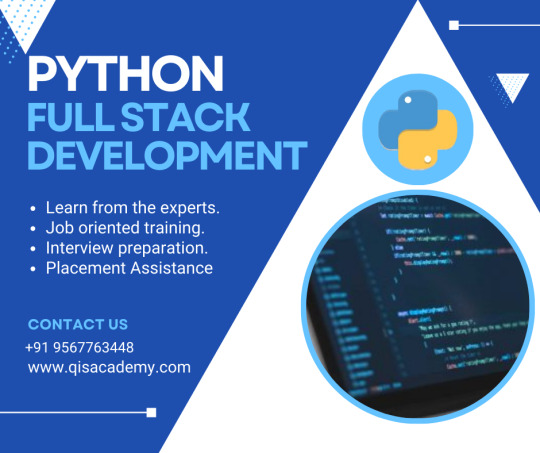
The Ultimate Guide to Python Training: Boost Your Career with the Best Python Course in Kerala
Python has emerged as one of the most sought-after programming languages in the tech world. Its simplicity, readability, and versatility make it the ideal language for everything from web development to data science and machine learning. If you’re looking to boost your career in the tech industry, enrolling in a Python training course is a smart investment. In this blog, we will explore why Python is so important, what you will learn in a Python course, and how enrolling in the Best Python Training Course in Kerala can help you achieve your career goals.
Why Learn Python?
Python’s popularity has skyrocketed over the past decade, and it is now one of the most widely-used programming languages in the world. Here are some reasons why Python is such a great language to learn:
Simplicity and Readability: Python’s syntax is clean, concise, and readable, making it easier for beginners to learn and understand. Unlike other programming languages, Python’s code resembles plain English, which minimizes the learning curve for new developers.
Versatility and Flexibility: Python can be used in a variety of fields, including web development, data science, artificial intelligence, machine learning, game development, and automation. This flexibility makes Python an essential language for anyone looking to work across multiple industries.
Large Ecosystem of Libraries and Frameworks: Python has a vast collection of libraries and frameworks that make coding faster and more efficient. Popular frameworks like Django (for web development) and Flask (for building APIs) are widely used, while libraries like Pandas, NumPy, and TensorFlow are central to data science and machine learning applications.
High Demand for Python Developers: Python’s adoption across various industries has led to a high demand for skilled Python developers. From startups to multinational corporations, companies are constantly seeking professionals who are proficient in Python.
Community Support: Python boasts a large, supportive community of developers who are constantly contributing to the language’s growth. With an abundance of online tutorials, forums, and documentation, it’s easy to get help and stay up to date with Python’s evolving features.
Best Python Training in Kerala: What You Will Learn
Enrolling in the Best Python Training Course in Kerala provides you with the skills necessary to excel in a wide range of programming roles. Whether you’re interested in web development, data science, or AI, a comprehensive Python course will teach you the skills you need to succeed. Here's an overview of what you can expect to learn in a top-tier Python training course in Kerala:
1. Introduction to Python
Setting up your Python development environment
Understanding basic syntax and writing your first Python program
Introduction to variables, data types, and operators
2. Control Flow and Logic
Mastering conditional statements like if-else
Using loops (for and while) to automate repetitive tasks
Learning how to handle errors and exceptions to make your code robust
3. Functions and Object-Oriented Programming (OOP)
Learning how to create reusable functions to modularize your code
Introduction to classes and objects, and understanding the principles of OOP like inheritance and polymorphism
Creating and using modules and packages in Python
4. File Handling and Data Processing
Working with different file types (text files, CSV, JSON)
Learning how to read, write, and manipulate files in Python
Introduction to libraries like Pandas for data manipulation
5. Libraries and Frameworks
Mastering Python’s rich ecosystem of libraries
Learning frameworks like Django and Flask for web development
Working with NumPy, Pandas, and Matplotlib for data analysis and visualization
6. Real-World Projects
Developing projects that help you apply the concepts learned
Working on web applications, automation scripts, or data science projects
Building your portfolio to showcase to potential employers
Python Training in Kerala: Why It’s the Best Investment
Kerala has emerged as a hub for IT education, with numerous training institutes offering Python training in Kerala. Whether you’re in Kochi, Calicut, Trivandrum, or Kannur, you’ll find institutes that offer specialized Python courses designed to meet the needs of today’s tech job market.
Here are a few reasons why taking a Python training course in Kerala is a great choice:
Experienced Trainers: The best Python training institutes in Kerala have trainers with real-world experience and expertise in Python development. These trainers not only teach the theoretical concepts but also provide practical insights into how Python is used in industry.
Industry-Relevant Curriculum: A top-tier Python course will cover all the fundamentals while focusing on real-world applications. You’ll learn how to build web apps, work with APIs, process data, and even build machine learning models.
Placements and Career Support: Many Python training institutes in Kerala offer placement assistance, helping you secure a job in top IT companies. From mock interviews to resume-building workshops, these institutes support your job search every step of the way.
Flexible Learning Options: Whether you prefer classroom learning or online courses, many institutes in Kerala offer flexible learning options. You can choose the schedule and format that best fits your lifestyle and goals.
Hands-on Experience: A quality Python training course will offer hands-on experience through projects and assignments, ensuring you’re ready to tackle real-world problems.
Full Stack Developer Course in Kerala: Expand Your Skillset
For those looking to take their programming skills to the next level, consider enrolling in a Full Stack Developer course in Kerala. A full stack developer is proficient in both front-end and back-end technologies, making them highly versatile and in-demand.
In a full stack development course, you’ll learn:
Front-End Technologies: HTML, CSS, JavaScript, React, or Angular for creating user interfaces.
Back-End Technologies: Node.js, Python, Django, or Flask for handling server-side logic.
Databases: SQL, MongoDB, and Firebase for data storage and management.
Version Control: Using Git for code versioning and collaboration.
Combining your Python skills with full-stack development knowledge will open doors to a wide range of job opportunities, such as web developer, software engineer, and full-stack developer.
Conclusion: Why Quest Innovative Solutions Is the Best Choice
If you’re looking for the Best Python Training in Kerala, Quest Innovative Solutions is the ideal choice. With expert trainers, industry-aligned curriculum, and hands-on training, Quest Innovative Solutions offers the most comprehensive Python training course in Kerala. Whether you’re interested in web development, data science, or machine learning, their Python course is designed to equip you with the skills you need to succeed in the tech industry.
Additionally, Quest Innovative Solutions offers Full Stack Developer courses for those who want to expand their knowledge and become proficient in both front-end and back-end technologies. Their focus on practical skills, industry relevance, and career support makes them the top choice for aspiring developers in Kerala.
Start your journey to a successful tech career with Python training in Kerala today. Enroll in a course at Quest Innovative Solutions and take your first step toward becoming a Python expert!
#full stack developer course in kerala#Best Python Training in kerala#Best python training course kerala#python training in kerala#Python full stack development training in kerala
0 notes
Text
Top 10 Skills to Look for in a Python Developer in 2025
As Python continues to be one of the most in-demand programming languages, businesses across all industries are on the lookout for skilled Python developers. Hiring the right developer is crucial to the success of your projects, and the fast-paced evolution of technology means that certain skills are more important than ever. To ensure you hire the best talent in 2025, here are the top 10 skills to prioritize when hiring a Python developer.
1. Expertise in Python Fundamentals and Advanced Features
A strong grasp of Python’s core concepts is the foundation of any Python developer’s skill set. This includes:
Data types, variables, and control flow
Functions, classes, and modules
List comprehensions, lambda functions, and error handling
Beyond the basics, developers should be familiar with advanced Python features such as decorators, generators, and context managers. Mastery of these advanced concepts shows that a developer can write clean, efficient, and scalable code.
2. Proficiency with Web Frameworks (Django, Flask, FastAPI)
Python’s strength in web development continues to grow, and expertise in popular frameworks is essential. Key frameworks include:
Django: Ideal for building large-scale applications with built-in tools for ORM, authentication, and admin dashboards.
Flask: A lightweight option for smaller or more flexible applications.
FastAPI: Perfect for building high-performance APIs with modern features.
A well-rounded developer should know when and how to use these frameworks to best suit the needs of a project, as well as have experience in deploying and scaling web applications.
3. Strong Knowledge of Data Structures and Algorithms
Efficient problem-solving relies on a developer’s understanding of fundamental data structures and algorithms. Key areas include:
Lists, dictionaries, sets, and queues
Sorting, searching, and optimization techniques
A deep understanding of these concepts ensures that Python developers can write code that is both efficient and scalable, especially when dealing with large datasets or computationally intensive tasks.
4. Experience in Data Science and Machine Learning
As Python is the go-to language for data science and machine learning, a developer with expertise in this area is highly valuable. Look for experience with:
Data manipulation libraries like NumPy, Pandas, and SciPy
Machine learning libraries such as Scikit-learn
Knowledge of deep learning frameworks like TensorFlow or PyTorch
These skills are essential for companies working with large datasets, AI, or predictive models.
5. Cloud Computing Knowledge
As businesses continue to move toward cloud-based infrastructures, Python developers need to be skilled in working with cloud platforms like AWS, Google Cloud, and Microsoft Azure. Look for developers who have experience with:
Deploying applications on the cloud
Using cloud storage, databases, and serverless computing
Integrating with services like Kubernetes and Lambda for scalable solutions
Cloud computing expertise ensures that your Python applications are scalable and ready for deployment in modern cloud environments.
6. Proficiency in Version Control (Git)
Version control is an essential skill for modern development workflows. Developers should be comfortable with Git, including tasks like:
Branching and merging code
Resolving conflicts
Using platforms like GitHub or GitLab
Proficiency in version control is crucial for smooth collaboration and maintaining a clean, organized codebase.
7. Testing and Debugging Skills
A great Python developer should not only write code but also ensure it works as intended. Look for experience with:
Writing unit tests and performing integration tests using frameworks like PyTest and unittest
Debugging and optimizing code
Ensuring robustness by identifying performance bottlenecks and bugs
Effective testing and debugging save time, improve quality, and help developers deliver reliable software.
8. Understanding of Security Practices
With data breaches and security threats becoming more common, Python developers should be aware of security best practices. This includes:
Preventing common vulnerabilities like SQL injection, XSS, and CSRF
Implementing encryption, hashing, and secure API development
Ensuring data protection and compliance with security regulations
Security awareness is vital for keeping applications safe and maintaining trust with users.
9. Strong Communication and Collaboration Skills
While technical expertise is key, soft skills like communication and teamwork are just as important. A Python developer should be able to:
Explain complex technical concepts to non-technical stakeholders
Collaborate effectively with team members on code reviews and problem-solving
Contribute to team efforts and maintain positive relationships
Good communication ensures smooth project execution and fosters a collaborative work environment.
10. Adaptability and Commitment to Continuous Learning
The tech industry evolves rapidly, and the best developers are those who stay curious and adaptable. Look for developers who:
Stay updated on the latest Python tools, libraries, and technologies
Participate in communities, courses, and industry events
Adapt to new challenges and evolving project requirements
An adaptable developer ensures that your projects remain innovative and can quickly integrate the latest technologies as they emerge.
Conclusion
In 2025, Python remains one of the most popular and versatile programming languages, making it essential to hire developers who are not only proficient in Python but also well-versed in other crucial areas like web development, data science, cloud computing, and security. Soft skills such as communication, collaboration, and adaptability are equally important to ensure smooth project execution and team success.
At Jurysoft, we specialize in connecting businesses with top-tier Python developers who possess both the technical expertise and the collaborative mindset needed to succeed. Whether you need a developer for a short-term project or a long-term partnership, we can help you find the right talent to drive your business forward.
By focusing on these 10 key skills, you can ensure that your next Python developer will be equipped to help your organization thrive in 2025 and beyond.
0 notes